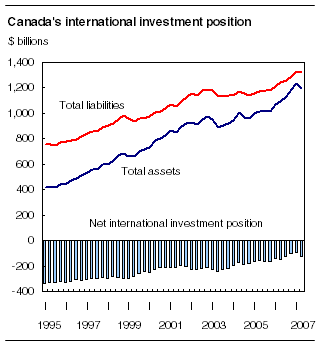Common menu bar links
Canada's international investment position
Archived Content
Information identified as archived is provided for reference, research or recordkeeping purposes. It is not subject to the Government of Canada Web Standards and has not been altered or updated since it was archived. Please "contact us" to request a format other than those available.

Canada's net external liabilities jumped during the second quarter of 2007 in the wake of a surging Canadian dollar.
The Canadian dollar value of both international assets and liabilities was down at the end of June. However, the decline in international assets, which are influenced more by exchange rate movements, was almost four times the decrease in liabilities.

As a result, net external liabilities (the difference between Canada's external assets and foreign liabilities) increased $32.0 billion to $124.4 billion.
The value of international assets fell to $1,193.1 billion, a drop of $44.0 billion from the previous quarter.
The dollar, which gained in value compared with major foreign currencies from March 31 to June 30, removed $76.8 billion from the value of these assets. This more than offset gains resulting from financial transactions, especially from investment in foreign bonds and stocks.
At the same time, the nation's international liabilities declined $12.0 billion to $1,317.6 billion. The impact of the strengthening Canadian dollar was partly offset by increased activity in international acquisitions of Canadian firms.
Currency valuationThe value of assets and liabilities denominated in foreign currency are converted to Canadian dollars at the end of each period for which a balance sheet is calculated. Most of Canada's foreign assets are denominated in foreign currencies while less than half of our international liabilities are in foreign currencies. When the Canadian dollar is appreciating in value, the restatement of the value of these assets and liabilities in Canadian dollars lowers the recorded value. The opposite is true when the dollar is depreciating. |
Net external liabilities at the end of June represented 8.1% of Canada's gross domestic product, up from 6.2% the previous quarter, which was a record low.
The Canadian dollar made appreciable gains against major foreign currencies in the second quarter. It gained 8.4% against the US dollar, 6.2% against the pound sterling, 7.0% against the Euro and 13.2% against the Japanese yen.
Assets: Substantial decline in the value of direct investment abroad
The stronger Canadian dollar in the second quarter had a large impact on the value of Canadian direct investment abroad, which fell by $28.0 billion to $508.2 billion at the end of June.
The injection of capital into existing affiliates was completely offset by the currency movements. The stronger dollar removed $37.2 billion from the value of Canadian direct investment abroad.
Canadian direct investment in the United States fell by $13.8 billion to $220.7 billion while Canadian direct investment in all other countries decreased by $14.2 billion to $287.5 billion.
Despite the negative impact of the stronger Canadian dollar, Canadian holdings of foreign bonds increased by $6.8 billion to $151.1 billion as Canadians made large purchases during the quarter, especially of maple bonds.
Holdings of foreign stocks decreased to $205.1 billion, down $13.5 billion from the end of March. At the same time, Canadian holdings of foreign money market paper decreased slightly to $19.8 billion.

Liabilities: Increase in foreign direct investment in Canada
Foreign investors added $10.0 billion to their direct investment position in Canada. Foreign direct investment in Canada reached $473.2 billion at the end of June.
Foreign direct investors were active in acquisitions of Canadian firms and this contributed to the increase.
Canada's net asset position on direct investment—the difference between Canadian direct investment abroad and foreign direct investment in Canada—decreased to $35.0 billion at the end of June, the lowest level since the third quarter of 2003.
Transactions in Canadian bonds reduced foreign holdings by $4.9 billion in the second quarter.
Combined with the currency effect (more than one-half of the outstanding Canadian bonds held by foreign investors are issued in foreign currencies), the total holdings of Canadian bonds fell by $25.0 billion to $385.1 billion.
Foreign holdings of Canadian stocks decreased slightly to $111.1 billion at the end of the quarter while foreign holdings of Canadian money market paper were up by less than $1 billion to $24.1 billion.

Available on CANSIM: tables 376-0037, 376-0039 to 376-0041, 376-0055 to 376-0057 and 376-0059.
Definitions, data sources and methods: survey number 1537.
The second quarter 2007 issue of Canada's International Investment Position (67-202-XWE) will be available soon.
For more information, contact Client Services (613-951-1855; infobalance@statcan.gc.ca). To enquire about the methods, concepts or data quality of this release, contact Christian Lajule (613-951-2062), Balance of Payments Division.


 Table(s).
Table(s).